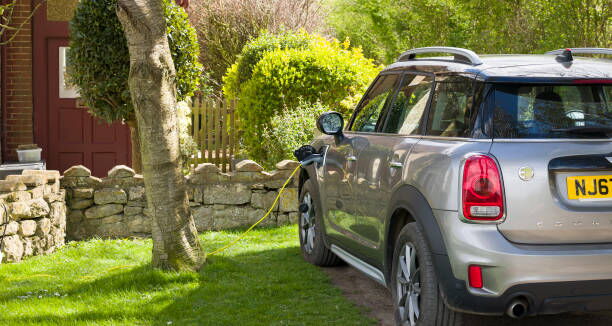As electric vehicles (EVs) become increasingly popular, having an efficient home charging solution is more important than ever. While public charging stations are useful for long trips, most EV owners do the majority of their charging at home. A Level 2 EV charger offers the perfect balance of speed, convenience, and affordability, making it the best choice for daily charging needs.
In this guide, we’ll cover:
What a Level 2 home EV charger is and how it compares to other charging options
The key benefits of installing a Level 2 charger at home
Different types of Level 2 chargers (plug-in vs. hardwired)
How renewable energy and smart charging can enhance your EV experience
The simple process of professional installation
By the end, you’ll understand why a Level 2 home charger is a smart investment for any EV owner.

A Level 2 EV charger uses a 240-volt electrical circuit, similar to what powers large appliances like electric dryers or ovens. Unlike a Level 1 charger (which plugs into a standard 120V outlet and provides only 3-5 miles of range per hour), a Level 2 charger delivers 32 to 80 amps of power, significantly reducing charging times.
Level 2 home EV chargers offer a significant upgrade in charging speed compared to standard Level 1 units. With the ability to add between 20 to 40 miles of driving range per hour, they dramatically reduce the time needed to recharge your electric vehicle. Most models deliver power outputs ranging from 7.7 kW up to 19.2 kW, allowing for a full charge in approximately 4 to 10 hours—perfect for overnight charging.
These chargers are compatible with all modern electric vehicles, and Tesla owners can easily connect using a simple adapter. Whether you're commuting to work or heading out on a weekend trip, a Level 2 charger ensures your EV is always ready to go.
With around 80% of EV charging done at home, having a Level 2 system installed provides unmatched convenience. It eliminates the stress of finding public charging stations and removes the worry of range anxiety. By charging at home, you gain independence, save time, and ensure your vehicle is fully powered every morning.
A Level 2 charger is up to 7x faster than a Level 1 charger. Instead of waiting 20+ hours for a full charge, most EVs recharge overnight. This is ideal for drivers with long commutes or frequent trips.
No more searching for public chargers or waiting in line. With a home charger:
Plug in at night, wake up to a full battery.
Avoid peak-hour pricing at public stations.
No detours—charge while you sleep or work from home.
While installation has an upfront cost, home charging is cheaper than public stations:
Saves ~1/3 compared to public charging fees.
Lower electricity rates during off-peak hours.
No subscription fees (unlike some charging networks).
Homes with pre-installed EV chargers are more attractive to buyers, potentially boosting resale value.
Many Level 2 chargers include:
Wi-Fi/Bluetooth connectivity for remote monitoring.
Scheduling options to charge during low-rate hours.
Energy tracking to optimize efficiency.
When choosing a Level 2 charger, you’ll typically have two installation options:
Requires a 240V outlet (NEMA 14-50 or NEMA 14-30, like those for dryers/ranges).
Easier to replace or upgrade since it’s not permanently wired.
Best for chargers under 40 amps (most home models).
Directly connected to the electrical panel for a more secure setup.
Required for high-power chargers (48A and above).
More durable, ideal for outdoor installations.
Note: If your home doesn’t have a 240V outlet, an electrician can install one during setup.
Pairing a Level 2 charger with solar panels can make charging nearly free and 100% renewable. Benefits include:
Lower electricity bills by using solar energy.
Reduced carbon footprint with clean power.
Potential tax credits for solar + EV setups.
A cutting-edge feature in newer EVs, bidirectional charging allows your car’s battery to:
Power your home (Vehicle-to-Home, V2H) during outages.
Supply energy back to the grid (Vehicle-to-Grid, V2G) for credits.
Act as a backup battery in emergencies.
Example: Ford F-150 Lightning and Nissan Leaf support V2H, turning your EV into a mobile power source.
Check your EV’s max charging rate (e.g., 32A, 48A).
Decide between plug-in or hardwired.
Look for ENERGY STAR-certified models for efficiency.
A professional ensures:
Safe, code-compliant installation.
Proper electrical panel upgrades (if needed).
Most areas require a permit for EV charger installations, followed by an inspection.
Once installed, simply plug in your EV and enjoy convenient home charging.
While DIY installation may seem tempting, professional installation ensures:
Safety (correct wiring, circuit protection).
Compliance with local electrical codes.
Warranty protection (many chargers require pro installation).
Optimal performance (proper voltage and grounding).
Ready to upgrade your home charging? Get a free quote today!
A Level 2 home EV charger is the best solution for faster, more convenient, and cost-effective charging. With speeds up to 7x faster than a standard outlet, compatibility with solar power, and emerging bidirectional charging technology, it’s a smart investment for any EV owner.
By choosing professional installation, you ensure a safe, efficient, and future-proof charging setup that enhances your EV experience for years to come.
Get started today and enjoy the benefits of hassle-free home charging!